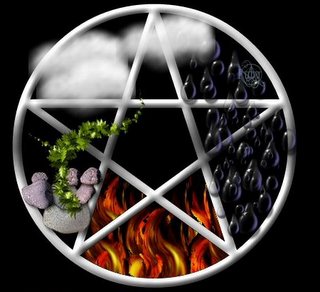Imbolg
 This next in my series on Pagan and Wiccan beliefs and Holy Days, or Sabbats as they are known brings us to Imbolg, a Celtic word meaning "in the belly". Imbolg is generally celebrated on the 2nd of February. Many people may know it by its Christianized title of "Candlemas". The "belly" being referred to is that of the Great Mother, as Imbolg rites recognize the first hints of spring and feel the new quickening of both life and spirit around us. We become aware of the Earth's first stirrings of her womb as the Sun's light shines upon us to dispel the gloom of winter.
This next in my series on Pagan and Wiccan beliefs and Holy Days, or Sabbats as they are known brings us to Imbolg, a Celtic word meaning "in the belly". Imbolg is generally celebrated on the 2nd of February. Many people may know it by its Christianized title of "Candlemas". The "belly" being referred to is that of the Great Mother, as Imbolg rites recognize the first hints of spring and feel the new quickening of both life and spirit around us. We become aware of the Earth's first stirrings of her womb as the Sun's light shines upon us to dispel the gloom of winter.In celebrating Imbolg we also turn to the light of the moon as the moon stands above all for her threefold aspects of Maiden, Mother and Crone ( Enchantment, Ripeness, and Wisdom). Thus, we see Pagan folk and Wiccans celebrating the feast of Brigid (Brid, Bride, Brigante) the radiant triple Muse-Goddess, who is also a fertility-bringer.
In some circles, "Brid's Bed", the union place of the Goddess and the Sun God, is created and placed within the circle, inviting the fertility of life that has begun anew around us. This is done by creating a female figure of straw or a "Brid's Cross", and laying it in a basket at the center of the circle, with a phallic wand across it, to symbolize the impregnation of the Mother.
Another tradition followed is that of lighting a need-fire, a welcoming beacon to show the Lady the way back to us; coveners move in a procession to the fire, placing candles in among the wood to ignite it. Some circles make a ceremony of "charming the plow", where they bless a spade or shovel with oil or wine before using it to dig a hole in the earth and bury an offering to the Mother.
In ancient Rome, February was the cleansing time -- Februarius mensis, "the month of purification", a time when the evergreens of Yule tide were swept up and burnt to prevent hobgoblins from haunting the home. This reflected the new change that begins to flow through the whole world of nature, and people made it a point to be rid of the past and look to the future.
Like Yule, Imbolg has its traditions and symbols that seem to peek out at us from the past. February marks the Roman celebration of Lupercalia or the Feast of Pan, in which the Priests of Faunnus, an ancient god of fertility, went about the streets of Rome dressed in goatskin loincloths, carrying thongs with which they struck women across the palms to promote fertility in them. The day of the 14th was held sacred to the Goddess Juno, Queen of the Heavens and personification of the three aspects of the Goddess. Needless to say, in taking part in the celebrations of our modern Valentine's Day, we pay honor to these rituals from our past.
Of course, we can't forget that cute little guy who is so well known and easily recognized this time of the year, the one with the arrows and bow. His name is Cupid (or Eros to the Greeks), the son of Venus, Roman Goddess of love. Cupid fell in love with Psyche, a girl so beautiful that Venus became jealous of her and through trickery and deceit caused Psyche to descend into the underworld of Hades, Land of the Dead. Cupid, however, discovered her and brought her back to life, and through his love Psyche became immortal. This same concept of life hidden away as if dead, and then brought back is seen in many stories. From the myths of Persephone and Demeter to that of Snow White, we are ever reminded of life that is hidden and then brought forth into the light in its ever turning cycle.
At Imbolg, we, like all of nature, await the coming of spring, the Vernal Equinox, when day and night are equal, which tells us that the light has truly vanquished the dark and a new change is upon the land. And so the Wheel of the Year turns.....
NOTE:
For those interested in honoring the Olde Gods and Goddesses and this time of rebirth and renewal, there will be an Wiccan Ritual for Imbolg at the Unitarian Church's Unitarian House at 818 Court St at Monument Terrace. in Lynchburg VA. Folks will start gathering around 7:00 PM with the Ritual starting at about 7:30PM.
Additional Links with Imbolg Info
Wikipedia
Witchvox.com
BBC
Wicca.com
Celtic Spirit.org


3 Comments:
"Good read Jeff!"
These pieces are always interesting Jeff!
DL
Hiya Jeff, well done and thanks for the seasonal pieces!
Charming the Plow is a Norse (Germanic & Scandinavian)tradition which involves preparing the field furrows (by burying a special bread, along with other thigns) as well as blessing the plow. It finds root in Norse lore in the story of how Freyr wooed the giantess Gerd.
For those interested in a Druid ritual focusing solely on the pre-Christian, Celtic tradtions, the local Grove's Oimelc ritual will be on Saturday, Feb. 4 at noon.
I mean, you know we love the local Wiccans, but the whole circle and the wand over the brideog is just not Celtic.
Post a Comment
<< Home